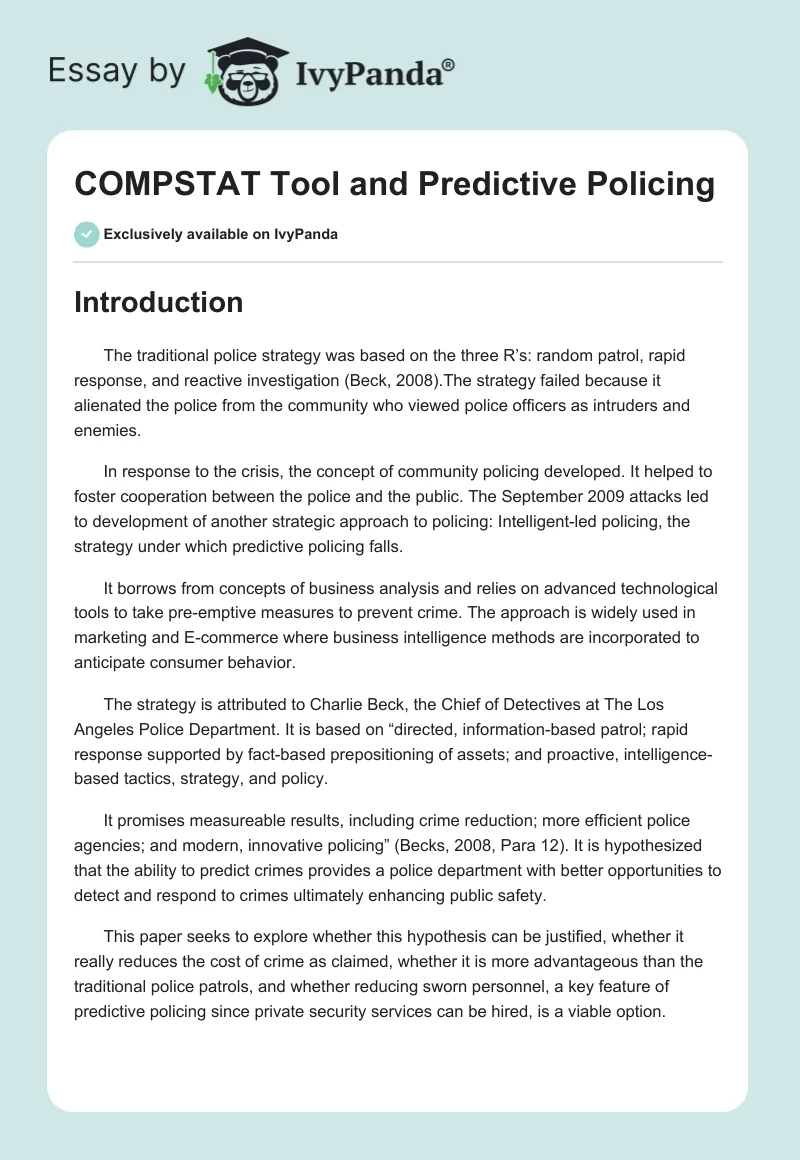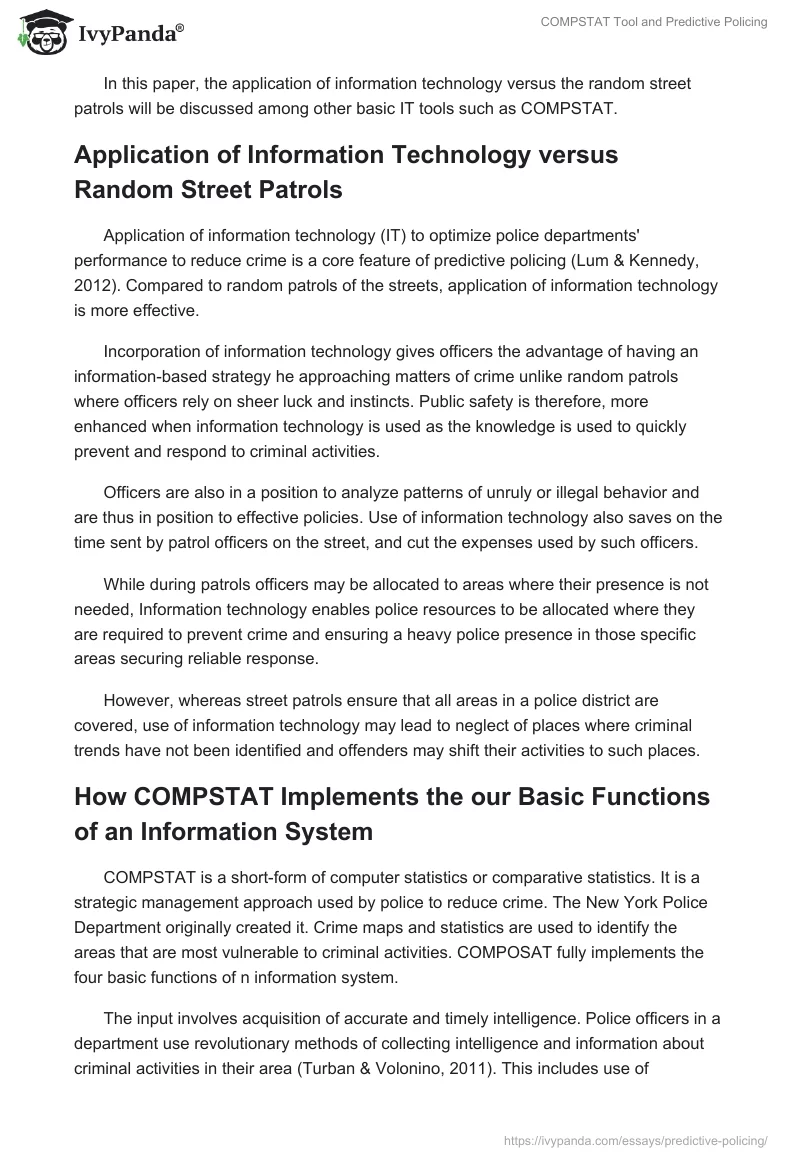Introduction
The traditional police strategy was based on the three R’s: random patrol, rapid response, and reactive investigation (Beck, 2008).The strategy failed because it alienated the police from the community who viewed police officers as intruders and enemies.
In response to the crisis, the concept of community policing developed. It helped to foster cooperation between the police and the public. The September 2009 attacks led to development of another strategic approach to policing: Intelligent-led policing, the strategy under which predictive policing falls.
It borrows from concepts of business analysis and relies on advanced technological tools to take pre-emptive measures to prevent crime. The approach is widely used in marketing and E-commerce where business intelligence methods are incorporated to anticipate consumer behavior.
The strategy is attributed to Charlie Beck, the Chief of Detectives at The Los Angeles Police Department. It is based on “directed, information-based patrol; rapid response supported by fact-based prepositioning of assets; and proactive, intelligence-based tactics, strategy, and policy.
It promises measureable results, including crime reduction; more efficient police agencies; and modern, innovative policing” (Becks, 2008, Para 12). It is hypothesized that the ability to predict crimes provides a police department with better opportunities to detect and respond to crimes ultimately enhancing public safety.
This paper seeks to explore whether this hypothesis can be justified, whether it really reduces the cost of crime as claimed, whether it is more advantageous than the traditional police patrols, and whether reducing sworn personnel, a key feature of predictive policing since private security services can be hired, is a viable option.
In this paper, the application of information technology versus the random street patrols will be discussed among other basic IT tools such as COMPSTAT.
Application of Information Technology versus Random Street Patrols
Application of information technology (IT) to optimize police departments’ performance to reduce crime is a core feature of predictive policing (Lum & Kennedy, 2012). Compared to random patrols of the streets, application of information technology is more effective.
Incorporation of information technology gives officers the advantage of having an information-based strategy he approaching matters of crime unlike random patrols where officers rely on sheer luck and instincts. Public safety is therefore, more enhanced when information technology is used as the knowledge is used to quickly prevent and respond to criminal activities.
Officers are also in a position to analyze patterns of unruly or illegal behavior and are thus in position to effective policies. Use of information technology also saves on the time sent by patrol officers on the street, and cut the expenses used by such officers.
While during patrols officers may be allocated to areas where their presence is not needed, Information technology enables police resources to be allocated where they are required to prevent crime and ensuring a heavy police presence in those specific areas securing reliable response.
However, whereas street patrols ensure that all areas in a police district are covered, use of information technology may lead to neglect of places where criminal trends have not been identified and offenders may shift their activities to such places.
How COMPSTAT Implements the our Basic Functions of an Information System
COMPSTAT is a short-form of computer statistics or comparative statistics. It is a strategic management approach used by police to reduce crime. The New York Police Department originally created it. Crime maps and statistics are used to identify the areas that are most vulnerable to criminal activities. COMPOSAT fully implements the four basic functions of n information system.
The input involves acquisition of accurate and timely intelligence. Police officers in a department use revolutionary methods of collecting intelligence and information about criminal activities in their area (Turban & Volonino, 2011). This includes use of advanced techniques and computer software such as Geographic Information soft wares, exploratory graphs, and artificial intelligence.
The processing function is implemented through effective tactics whereby crime incidents and emergencies are not treated as isolated incidents. Other factors are considered during response to crime such as the social-environmental issues that could have contributed to the crime.Ths holistic approach ensures effective processing of data and information.
The output involves response measures such as rapid deployment. During situations of emergency, police bosses have to struggle with deployment of officers.
COMPOSAT however, enables them to allocate personnel resources strategically based on crime patterns and recent occurrences and enables them to allocate the tsk to the most qualified officers whereas the feedback option is seen through relentless follow-up and assessment.
This is because the efficiency of the police in reducing crime is constantly assessed through crime maps and statistics. The rate depends on the particular police department and it can be weekly or monthly. Unsuccessful tactics are then dispensed and replaced with more innovative ones.
How Information Systems have Enabled Fast Response to Crimes
Information systems such as COMPSTAT have helped police departments to respond to crimes faster through many ways. Police chiefs can allocate resources and personnel more effectively based on intelligence acquired through such information systems and are thus in a position to deploy faster.
The information systems are used to detect fraud and identity theft through use of advanced statistics. Drug activities and drug cartels including the activities of drug-lords and their cronies are monitored by such systems thus police are able to respond faster when the masterminds try to put their plans into actions because they already have the blueprint.
Police are also able to provide quick relief in case of emergencies or disasters since the information systems can detect the occurrence of these events before they can happen.
Swot Analysis
A police department cannot apply predictive policing out of the blues or without a policy framework. Such a department may wish to consider a Strengths, Weaknesses, Opportunities and Threats (SWOT analysis).
Strengths of predictive policing are that it helps to prevent crimes, police are able to respond faster and public safety is enhanced. The weaknesses are that it requires hiring of specialists, it infringes on the individual’s right to privacy breaching The Fourth Amendment of The Constitution, and minorities can be easily targeted for commission of crimes.
There are many opportunities in predictive policing such as introduction of more advanced soft wares and statistics analysis methods and a department may boost public confidence due to reduction of criminal activities.
The threats are that criminals may hack into the information systems and access crucial and confidential data. Reduction of personnel may also lead to bad blood in the police force.
Conclusion
From the above discussion, it is clear that the introduction of information technology in the police departments has significantly influenced the performance of the police force. This is especially in terms of crime identification and solving.
Reference List
Beck, C. (2009). Predictive Policing: What Can We Learn from Wal-Mart and Amazon about Fighting Crime in a Recession? The Police Chief. Retrieved from: http://www.policechiefmagazine.org/predictive-policing-what-can-we-learn-from-wal-mart-and-amazon-about-fighting-crime-in-a-recession/
Lum, M., & Kennedy, L. (2012). Evidence-based counterterrorism policy. New York: Springer.
Turban, E. & Volonino, L. (2011). Information technology for management: Improving strategic and operational performance. Hoboken, NJ: John Wiley.


